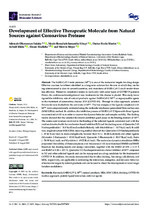| dc.contributor.author | Fadaka, Adewale Oluwaseun | |
| dc.contributor.author | Sibuyi, Nicole Remaliah Samantha | |
| dc.contributor.author | Martin, Darius Riziki | |
| dc.contributor.author | Klein, Ashwil | |
| dc.date.accessioned | 2021-09-21T13:23:08Z | |
| dc.date.available | 2021-09-21T13:23:08Z | |
| dc.date.issued | 2021 | |
| dc.identifier.citation | Fadaka, A.O.; Sibuyi, N.R.S.; Martin, D.R.; Klein, A.; Madiehe, A.; Meyer, M. Development of Effective Therapeutic Molecule from Natural Sources against Coronavirus Protease. International Journal Molecular Sciences 2021, 22, 9431. https://doi.org/ 10.3390/ijms22179431 | en_US |
| dc.identifier.uri | https://doi.org/ 10.3390/ijms22179431 | |
| dc.identifier.uri | http://hdl.handle.net/10566/6732 | |
| dc.description.abstract | Abstract: The SARS-CoV-2 main protease (Mpro) is one of the molecular targets for drug design. Effective vaccines have been identified as a long-term solution but the rate at which they are being administered is slow in several countries, and mutations of SARS-CoV-2 could render them less effective. Moreover, remdesivir seems to work only with some types of COVID-19 patients. Hence, the continuous investigation of new treatments for this disease is pivotal. This study investigated the inhibitory role of natural products against SARS-CoV-2 Mpro as repurposable agents in the treatment of coronavirus disease 2019 (COVID-19). Through in silico approach, selected flavonoids were docked into the active site of Mpro. The free energies of the ligands complexed with Mpro were computationally estimated using the molecular mechanics-generalized Born surface area (MM/GBSA) method. In addition, the inhibition process of SARS-CoV-2 Mpro with these ligands
was simulated at 100 ns in order to uncover the dynamic behavior and complex stability. The docking results showed that the selected flavonoids exhibited good poses in the binding domain of Mpro. The amino acid residues involved in the binding of the selected ligands correlated well with the residues involved with the mechanism-based inhibitor (N3) and the docking score of Quercetin-3-O-
Neohesperidoside (−16.8 Kcal/mol) ranked efficiently with this inhibitor (−16.5 Kcal/mol). In addition, single-structure MM/GBSA rescoring method showed that Quercetin-3-O-Neohesperidoside (−87.60 Kcal/mol) is more energetically favored than N3 (−80.88 Kcal/mol) and other ligands (Myricetin 3-Rutinoside (−87.50 Kcal/mol), Quercetin 3-Rhamnoside (−80.17 Kcal/mol), Rutin (−58.98 Kcal/mol), and Myricitrin (−49.22 Kcal/mol). The molecular dynamics simulation (MDs) pinpointed the stability of these complexes over the course of 100 ns with reduced RMSD and RMSF. Based on the docking results and energy calculation, together with the RMSD of 1.98 ± 0.19 Å and RMSF of 1.00 ± 0.51 Å, Quercetin-3-O-Neohesperidoside is a better inhibitor of Mpro compared to N3 and other selected ligands and can be repurposed as a drug candidate for the treatment of COVID-19. In addition, this study demonstrated that in silico docking, free energy calculations, and
MDs, respectively, are applicable to estimating the interaction, energetics, and dynamic behavior of molecular targets by natural products and can be used to direct the development of novel target function modulators. | en_US |
| dc.language.iso | en | en_US |
| dc.publisher | MDPI | en_US |
| dc.subject | SARS-CoV-2 | en_US |
| dc.subject | flavonols | en_US |
| dc.subject | natural products | en_US |
| dc.subject | protein-ligand interaction | en_US |
| dc.subject | antiviral agents | en_US |
| dc.subject | MM/GBSA | en_US |
| dc.title | Development of Effective Therapeutic Molecule from Natural Sources against Coronavirus Protease | en_US |
| dc.type | Article | en_US |

